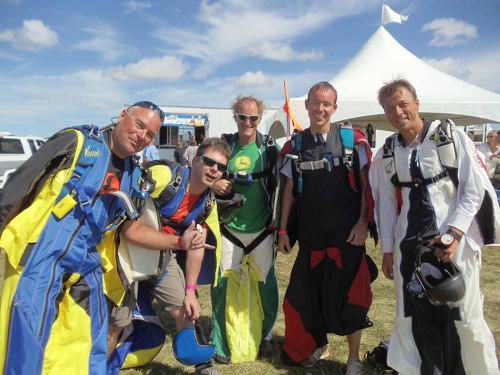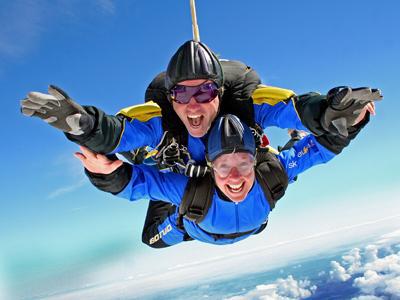An Introduction to Piece Flying on Formation Skydives
(This article was first published in the August 2004 issue of Parachutist as “One Good Turn Deserves Another”. Since then, the article has been updated and improved.)
Turning a piece on a formation skydive is not as simple as yanking it around and hoping it will stop where it is supposed to. Jumpers in the piece must help it stay close and level throughout the turn, and they must help their piece partners start and stop the turn without rotating it too far or slamming it into the other piece.
A piece that is yanked around too fast can rotate too far or even injure somebody. A piece that is not completely turned or turned incorrectly can drift away and actually become harder to control. This article shows the correct (and safe) techniques for turning pieces on recreational RW loads.
Meet the minimum skill level
Before jumpers participate in a skydive that involves piece turning, they should meet the requirements for a USPA A license, which means that they can do individual 360-degree turns, dock on another skydiver, maintain eye contact, track, wave off, and pull. In addition, jumpers should be able to dock on small formations such as a 4-way Star.
Start with partial turns
Newer jumpers should start with partial turns (180 degrees or less) on small formations. Here is a fun drill. Build a 4-way Open Accordion, break it in the middle, turn the two pieces 180 degrees and re-dock. This puts the jumpers who were on the inside on the outside, and vice versa.
In this drill, think more about “trading places” with your piece partner than about turning the piece. The piece will automatically rotate if you move to the slot vacated by your piece partner. As you move, try to help place your piece partner in the spot you just vacated, keeping your piece level with the other piece as you do. Repeat the process to place yourselves back in your original slots then repeat the drill until breakoff.
Move on to 360-degree turns
Once you can do drills like the one described above, you are ready to move on to 360-degree turns on small formations. A good drill for this is the Zig Zag – Marquis 4-way block.
A “block” is a two-formation set in which jumpers build the first formation, split into pieces, rotate the pieces then reconnect them to form the second formation. In competition, experienced teams speed up their turns by rotating the end of one piece over the end of the other piece – in essence, reducing a 360-degree turn to 270 degrees or even less. But in this article, we only discuss flat turns because they normally work best on recreational loads where the objective is not speed but smooth level turns.
In the Zig Zag – Marquis block shown above:
To start the turn, Jumpers A and B break grips and turn approximately 90 degrees to the right and stop, keeping each other in view over their left shoulder (helps them stay close and level). While this is happening, Jumpers C and D stay put except to extend their arms to let Jumpers A and B move.
Once Jumpers A and B have moved, Jumpers C and D “trade places”, keeping each other in sight over their left shoulder as they move. When their legs almost touch, they stop, look over the other shoulder (called a “head switch”) and place Jumpers A and B together in the Marquis.
While Jumpers C and D are finishing their turns, A and B also do a “head switch” and keep each other in view and on level while they are placed together.
All jumpers should help keep the pieces level throughout the turn.
Notes:
To be safe while they trade places, Jumpers C and D do not move directly at each other, but slightly offset so that their legs do not collide.
Also if they focus on “trading places” rather than spinning their partners around, the pieces are more likely to stay close.
The same concepts used for the Zig Zag – Marquis example above can be applied to turning pieces in larger formations. Consider the following example.
In the 9-way example above:
Jumper A turns approximately 90 degrees to the right and stops, keeping the other pieces in view over his left shoulder (helps him stay level and close).
Jumper B moves into the space cleared by Jumper A. At the same time, Jumper C moves into the space vacated by Jumper B.
As soon as Jumper A feels the piece rotating, he looks over his right shoulder for the other pieces and stays level with them as the turn finishes.
As the turn finishes, Jumpers B and C place Jumper A back into his original slot.
All jumpers should help keep the pieces level throughout the turn.
Note: Everybody’s initial moves should create enough momentum to keep the piece rotating. If it starts rotating too fast, Jumpers B and C can lower their right knee temporarily to put on the brakes. Similarly, if the piece stops rotating too soon, they can lower their left knee until it starts moving again.
Rotate pieces on their center points
To keep the pieces close throughout the turn, each jumper must help the piece rotate on its center point. Jumpers in each piece should watch the other piece over one shoulder as the turn starts, then “head switch” and watch it come back into view over the other shoulder as the turn completes. This helps keep the pieces close and on level and emphasizes the following point: If you keep your target in sight, you will be more likely to fly to it.
Get the right grips
In the dirt dive, jumpers should practice the grips they will be taking in the air. This way they won’t be fumbling around for grips when the piece starts turning.
Also a grip should not hinder a piece partner’s ability to fly. This is especially true of leg grips. Do not grip at or below the knee because this hinders your piece partner’s ability to move his leg. Instead, grip as high as you can on the outside of his thigh so that when he moves his leg your grip doesn’t move much at all.
Tip! High, outside leg grips also help people with short arm spans to fly when they have Sidebody grips. Sidebody grips consist of an arm and a leg grip on the side of your piece partner. It is much easier to fly if your arms aren’t all stretched out.
Slow is Fast
If the pieces drift apart and get on different levels during a turn, jumpers should not try to make up the distance too quickly. They should get the pieces level first then slowly make up the horizontal distance. Slamming the pieces together in a rush can possibly injure somebody or even cause a funnel. At the very least, it creates a wave throughout the formation that must be dealt with before jumpers break for the next point. If jumpers break before the formation settles down, they will more than likely end up on different levels again. It actually takes less time to get the pieces level and fly them smoothly back together than it does to slam them together then have to deal with an unstable formation. As often is the case, slow is fast.
Give it time
Like any skydiving technique, learning to turn pieces effectively takes time. Don’t expect to run straight from your A license exam to jumping on the hot RW loads. Practice on small formations first. Do some 4-way; there is no better training tool for learning how to turn pieces.
With practice, you’ll learn to anticipate your moves and to work with other jumpers in the piece. Piece turning is definitely a group effort and when everybody is working together, it feels like the piece has eyes and a mind of its own as it does a smooth, quick and controlled 360-degree rotation then stops on a dime and makes a perfect re-dock on the other pieces!
By elightle, in Disciplines,



